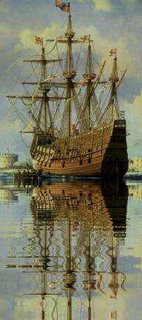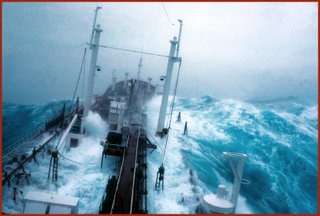This will be a slightly long post today, because I composed a long, and hopefully reasonably complete, list of the well known cases of ships encounter freaque waves.
Because I did it only through quick searches on the internet, it is contingent on the information made available on the internet at the present, the list is necessarily cursory.
I have tried to include their appropriate internet sources for easy check and reference. This list will be continuously updated when new information becomes available.
1498: While on his third voyage on August 4, 1498, Columbus’ fleet of six ships was en-route along the southern tip of Trinidad to the Gulf of Paria when Columbus heard a fearsome roaring from behind his flagship. He turned to see a rogue wave as high as the ships masts and approaching faster than the fleet could escape. It lifted the vessels; hoisting them higher than anything the Admiral had ever experienced and then dropped the fleet into a huge trough. But it didn't stop the ships. Once the wave was behind, the flotilla hastened to escape the constricted passage they had just sailed through, to get to the Gulf. Columbus named the passageway "Mouth of the Serpent." (http://ycaol.com/demons_of_the_deep2.htm)
1545: Mary Rose, four masted warship, built on the orders of King Henry VIII between 1510 and 1511. She was one of the first ships able to fire a broadside, and was a firm favorite of Henry VIII. After a long and successful period of service she sank on July 19, 1545. See here.
1881: October, 1881, Firth of Forth, North Sea, the Alice of Boddam had left Fisherrow harbour five days previously, while attempting to return to Dunbar following a spell of bad fishing encountered a devastating storm. In the midst of the turmoil, the boat was seen half a mile away from Dunbar harbour when two massive waves struck sinking the vessel with all her crew. (Based from here.)
1883: On February 14, 1883 while en-route from Liverpool to Boston, the 320 - foot steamship Glamorgan was hit by an enormous wave that swept the captain and seven men overboard. On February 16, the ship was sighted by the steamship, Republic, which took off 44 survivors before the Glamorqan sank. (http://ycaol.com/demons_of_the_deep2.htm).
1884: Steamer Daniel Steinmann, an iron ship of 1,785 tons from Antwerp to Halifax, was wrecked at Sambro south of Halifax the night of April 3, 1884. Ninety passengers and thirty-four of the crew were drowned. Only the captain and several men were saved. According to the captain's statement ". . . At the same time an immense wave came pouring over her, carrying off every living soul. . ." and also by second boastwain: ". . . Just at that moment a heavy wave swept over the ship under which it sank. . ." See here.
1884: The yacht Nignonette set sail on May 19, 1884, from Southampton, England, bound for Sydney, Australia on a 12,000-mile voyage. Off the coast of West Africa the vessel was hit by a monstrous storm system. After four terrifying days battling towering waves and hurricane-force gales, a monstrous forty-foot "rogue" wave sunk the Mignonette. The captain and his three-member crew were cast adrift a thousand miles from land in a leaky 13-foot dinghy. After 19 days adrift, with no food or water, the captain resorted to killing the 17-year-old cabin boy for food and to try and save the lives of three left aboard. Five days later, a passing ship rescued them. (http://ycaol.com/demons_of_the_deep2.htm)
1905: Late on the evening of August 27, 1905, the steamer Peconic was struggling to make its way southward along the Georgia coast. Bound from Philadelphia to New Orleans with a cargo of 1,500 tons of coal, she was in the midst of a fierce gale that she encountered earlier in the day. Just after midnight on August 28, the officer of the deck gave the order to put further out to sea, as he feared they were approaching perilously close to the beach. As the steamer was in the process of turning to port, an immense wave rolling in from the northeast struck the vessel. The unfortunate timing of the blow caused a shift in the cargo of coal, and the Peconic heeled over and almost immediately sank. The sinking was so swift that only two of her crew survived; twenty souls went down with the ship. Detailed story here.
1909: South Indian Ocean. On July 29, British SS Waratah disappeared on her return maiden voyage from Sydney to London, while en route from South African’s Durban to Cape Town. No trace of the ship with 211 passengers and crew was ever found.
(http://en.wikipedia.org/wiki/Waratah_(ship) )
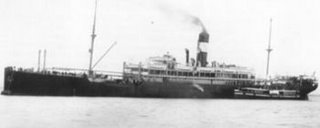
1909: On the morning of 3rd December 1909 the SS Ellan Vannin of the Isle of Man Steam Packet Co. left the Island at 01.13 bound for Liverpool. She was carrying 15 passengers, 21 crew plus mail and 60 tons of cargo. In command was Captain James Teare of Douglas with 18 years of experience. At departure the weather was not particularly rough, and though the barometric pressure was falling, the captain did not expect any trouble. As the passage progressed the weather rapidly deteriorated and by 06.35 when she arrived at the Mersey Bar the wind had increased to storm force 11 with 20 foot waves. She foundered between the Mersey Bar and the Q1 buoy on the Mersey approach channel. She filled with water and sank by the stern. All passengers and crew were lost. (See
here and
this)
1916: Lake Erie. October 29, 1916, the Colgate, a whaleback steamer, designed for heavy weather, but it couldn't take the waves during the notorious Black Friday, 1916. Three men managed to make it to the liferaft when the ship plunged nose first, but only the skipper would make it ashore. Today the wreck is upside down in 80 feet of water in the middle of Lake Erie. (See here.)
1929: Lake Michigan. September 9, 1929, the Andaste carried a load of gravel from Grand Haven heading southwest toward Chicago but never arrived. There was small craft warnings posted after her departure. The bodies of 14 of the 25 crew mem bers ultimately floated to shore, 11 of them wearing life jackets. (http://www.macatawa.org/~crich/andaste.htm)
1929: Lake Michigan. September 9, 1929, Andaste carried a load of gravel from Grand Haven heading southwest toward Chicago but never arrived. There was small craft warnings posted after her departure. The bodies of 14 of the 25 crew mem bers ultimately floated to shore, 11 of them wearing life jackets. (http://www.macatawa.org/~crich/andaste.htm)
1933: A 112-foot wave strikes the Navy tanker Ramapo in the North Pacific during a storm on February 7. The wave is so tall that it lines up with the ship’s crow’s nest.
(http://www.leelanau.com/waterfall/soundandfury.html)
1942: In December 1942, the Queen Mary was hit by a 23 meter (75 foot) wall of water while carrying 15,000 American troops from New York harbor to Southampton, England.
(http://www.book-of-thoth.com/thebook/index.php/RMS_Queen_Mary)
1943: North Atlantic. Cruise liner Queen Elizabeth ploughs into a trough and is hit by two massive waves in succession. The impacts shatter the bridge windows 28 meters above the waterline. (http://seastead.org/localres/misc-articles/lawton_newsci_06_30_01.html)
1944: Indian Ocean. British Royal Navy cruiser Birmingham plunges into a deep hole then takes a huge wave over her bows. The commander reports wading through knee-high water on a deck more than 18 meters above sea level.
(http://seastead.org/localres/misc-articles/lawton_newsci_06_30_01.html)
1951: North Atlantic. In December 1951 as SS Flying Enterprise, a 6,711 ton ship, en route from England to the United States, she encountered a severe North Atlantic storm, suffered hull cracks and took on a heavy list to port. For nearly two weeks thereafter, Flying Enterprise's Master, Captain Henrik Kurt Carlsen, remained aboard his ship as efforts were made to tow her to port. He was finally forced to abandon her when the list increased to a fatal degree on 10 January 1952, only about 40 miles away from Falmouth, England. The ordeal of the Flying Enterprise and Captain Carlsen was World-wide news at the time and remains one of the great stories of endurance and courage at sea. See here and here.
1966: North Atlantic. Italian steamship Michelangelo is hit by a 21-metre wave en route to New York. The water smashes through the bridge and into the first class compartments, killing two passengers and a crew member.
(http://www.fettes.com/shetland/wave%20environment.htm)
1968: On June 13, 1968 the tanker World Glory, carry 49,000 tons of crude oil, encountered an abnormally large wave 105 km east of Durban, South Africa, broken in half , and both halves sunk within 4 hours.(http://www.dynagen.co.za/eugene/freaks.html)

1973: A rogue wave off the coast of Durban, South Africa, strikes the 12,000-ton cargo ship Bencrauchan. The ship is towed into port, barely floating.
(http://brucestutz.com/articles/rogue3.htm)
1973: The cargo vessel Neptune Sapphire on her maiden voyage, carrying about 15 thousand tons of various cargo. The impact of a single, large wave off the south eastern shores of Africa caused the bow and 61 m of the forward part of the ship to break away and sink. The remainder of the ship was towed to East London. According to Capt. DAI DAVIES, Smit Marine South Africa, this big wave just came out of nowhere, hit the bow and destroyed the whole bow.
(http://www.oceansatlas.com/unatlas/issues/emergencies/OceanPhenHDNO/Dangerous.html)
1975: On November 10, 1975 the SS Edmund Fitzgerald sank in Lake Superior. All 29 crew members were lost. Details here and
(http://cimss.ssec.wisc.edu/wxwise/fitz.html).
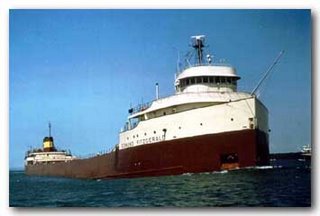
1976: The oil tanker Cretan Star in Indian Ocean off Bombay radios for help: “Vessel was struck by a huge wave that went over the deck.” The ship is never heard from again. The only sign of the vessel's fate was 6 km oil slick.
(http://ycaol.com/demons_of_the_deep2.htm)
1978: On 7 December, 1978, the German merchant navy, super-tanker München, en route to America, disappeared off the face of the earth. All that was found of the München and her 26 crew was a lifeboat that had suffered an incredible battering. She was one of the biggest ships ever built - the length of two-and-a-half football pitches - and unsinkable, as it was claimed.
(http://www.oceanpix.co.uk/Special-articles/Freak-waves-and-wave-simulation.htm)
1980: A huge wave was reported to have slammed into the oil tanker Esso Languedoc off the east coast of South Africa. (http://www.abc.net.au/science/news/space/SpaceRepublish_1161681.htm)
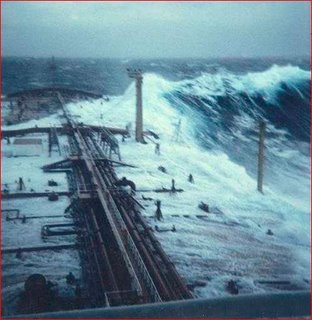
1980: On or about September 9th 1980, The MV Derbyshire sank off the coast of Japan in position apparently 25o 30' North, 130o 30' East. There were forty four people on board, including two wives; there were no survivors. The ship had been hove to in Typhoon Orchid (Typhoon 15, 16). There were no Mayday calls. She was en route for Kawasaki, Japan with a cargo of Iron Ore Concentrates (Caroline Concentrates) loaded at Sept Isles, Canada.
(http://www.wemt.nl/RINA%20paper.pdf)
1982: Not only ships, Offshore platforms may encounter freaque waves and facing demise also. On 15 February 1982, a giant wave smashed through the ballast control room window of the oil drilling platform Ocean Ranger off the coast of Newfoundland, short circuiting the electrical system and none of the crew could be warned. The rough seas caused the platform to sink and all 84 onboard were lost with no survivors. Check here or here for details and aftermath.

1984: North Atlantic. On June 3, 1984 the three-masted brig Marques encountered a freaque wave 75 miles north of Bermuda and lost in 45 seconds. Of the 28 onboard, there were only 9 survivors. See here.
1985: On April 27, 1985 the tanker of former Soviet Union Taganrogsky Zaliv encountered a freak wave and a seaman was killed and washed overboard. According to the description of the ships crew, the unusual wave looked like a deep hole in the sea, which appeared so suddenly in front of the ship that it was practically impossible to make any precaution measures to avoid ship’s sliding down into the deep wave trough.
(http://www.icms.org.uk/meetings/2005/roguewaves/presentations/Lavrenov.pdf)
1991: On November 4, 1991 a major storm, originally referred to as the "Halloween Nor'Easter" and hence recoined the "Perfect Storm" by a meterologist and made famous by Sebastian Junger's book and a Hollywood production, harrassed boats from Nova Scotia down to the New Jersey coast. The 70' longliner Andrea Gail went down in that storm and with her went the crew of six swordfishermen. See details here and here.
1995: In September, the cruiser liner Queen Elizabeth II encountered a 29-metre rogue wave in the North Atlantic that Captain Ronald Warwick described as "a great wall of water - it looked as if we were going into the White Cliffs of Dover"
(http://www.vos.noaa.gov/MWL/dec_04/rogue.shtml)

1998: North Atlantic.
Schiehallion, a BP Amoco floating production platform, is struck by a wave which smashed 18 meters above the waterline on November 9, 1998.(
http://w3g.gkss.de/projects/maxwave/workp/wp4.pdf)
2000: September 28, 2000: The P & O luxury liner ORIANA was hit by a 40 foot wave which smashed through six cabins as she sailed to Southampton from New York. ORIANA was 600 miles west of Ireland in rough seas when the wave hit.
(http://www.maritimematters.com/shipnews2000.html)
2001: In the week between February and March, two tourist cruisers, the Bremen and the Caledonian Star, had their bridge windows smashed by 30-metre rogue waves in the South Atlantic. (http://www.oceanpix.co.uk/Special-articles/Freak-waves-and-wave-simulation.htm)
2001: On September 5, 2001 the bulk carrier
Ikan Tanda, ran aground off Scarborough on the southern Cape Peninsula's Atlantic coast, at the mercy of what has been described as the worst storm for 50 years. The same storm blew a fishing vessel onto the breakwater in Table Bay. Details
here.

2002: December 15, 2002, MS Hanseatic of the Radisson Seven Seas was struck by a large rogue wave while on a coastal cruise of New Zealand. It broke out one of the bridge windows and damaged electrical systems, there were no major injuries reported. See here and here.
2005: MV EXPLORER (ex
OLYMPIC EXPLORER,
OLYMPIA EXPLORER) was struck by a fifty foot wave while sailing 650 miles south of the Aleutian Islands and about 1,600 miles from
Honolulu. The wave smashed through the bridge windows of the 591-foot ship around 2:30pm January 26. The salt water poured over electrical instruments and disabled all four engines. One engine was brought back online about an hour later and still later, a second, giving about 10 knots. (
http://www.maritimematters.com/shipnews2005a.html)
2005: Medterranean, February 14, 2005, The cruise ship Grand Voyager encountered Force 11 gale and ferocious waves up to 46 feet high (some say 50 feet), knocked out electric power, stopped the engine, and the ship was left helplessly adrift. See here. (http://www.thetravelinsider.info/blogs/ti/archives/2005/02/anyone_for_dram.html)
2005: April 2, 2005 the commercial fishing boat Tracie Lynn. The Tracie was hit by a rogue wave approximately 30 feet tall during a heavy storm off the shore of North Carolina. Two of the crew members were recovered. Johnny W. Brown, 38 years old fisherman out of Murrells Inlet was never seen again. ( see here.)
2005: North Atlantic, April 16, 2005, A "freak wave" more than 70 feet high slammed a luxury cruise ship steaming for New York. The Norwegian Dawn, an opulent ocean liner almost 1,000 feet long, limped into Charleston, S.C. after it hit vicious seas in an overnight storm off Florida - then was creamed by the rogue wave after dawn. What's really relevant here is the comment by the Norwegian Cruise Line spokesperson: "The sea had actually calmed down when the wave seemed to come out of thin air at daybreak. Our captain, who has 20 years on the job, said he never saw anything like it."
(http://www.nydailynews.com/front/story/300826p-257523c.html)
2006: May 14, 2006, Trawler Kotuku, The 50 ft Trawler Kotuku sunk in Foveaux Strait, between Bluff & Stewart Island, NZ with a loss of 6 lives. Four of them were from the same family and covered 3 generations. There were 3 survivors. It was reported that two big waves struck so suddenly and violently that no one caught in the Foveaux Strait trawler tragedy had a chance to react. (Noted from here and news reports, e.g., here. )
2006: May 22, 2006, Brittany Ferries was forced to divert its flagship vessel, mv Pont-Aven, to a port in northern France last night after it was hit by a freak wave that smashed a cabin window and flooded several cabins. The 41,000-tonne Pont-Aven,with 1,149 passengers onboard, was sailing from Plymouth to the Spanish port of Santander through a force nine gale when it was hit by a wave thought to be 40 ft high.
(http://www.timesonline.co.uk/article/0,,13509-2191940,00.html)

2006: On the morning of october 18, the 58 ft fishing vessel Ocean Challenger rolled over and capsized in the stormy northern Pacific Ocean about 90 miles south of Sand Point, Alaska. According to the Coast Guard, in the frenzied moments before the boat capsized, the fishermen launched a life raft. But none of them were able to get in it, overtaken by waves two stories high. A Coast Guard C-130 plane rescued one. The C.G. rescu swimmer was able to reach two others, including the skipper of the boat, but both were pronounced dead by the flight surgeon. There is still one crew missing.
2006: On November 11, the 42,000-tonne oil tanker FR8 Venture was hit by huge waves while passing through the Pentland Firth, one of the world's most notorious stretches of water. Two crewmen,who have been standing on the deck, were killed and another seriously injured as the ship was caught in a gale force eight storm and buffeted by waves over 20 feet high. "The ship may have got hit by a freak wave." said the coastguard. (See here.)
2006: On November 17, a rogue wave sank a 35 ft commercial fishing boat off the coast of Florida nearly killing the captain and another crew member. (See here and here.)
2006: On December 8, the Barque Picton Castle encountered gale force conditions while on passage from her homeport of Lunenburg, Nova Scotia, to the West Indies. At approximately 2200, the ship's decks were overwhelmed by an unusually large wave and crew member Laura Gainey of Montreal, Canada, was swept overboard. The ship immediately stopped, deployed life saving gear, and employed all of its extensive emergency and communications equipment in the call for assistance. Search and rescue efforts began immediately. Assisted by fixed wing aircraft from the Canadian and United States Coast Guard, as well as two merchant vessels, the Picton Castle, her captain and crew scoured the Atlantic for four days without respite in hopes of finding their shipmate. Their search was suspended December 12. (See here.)
2006: On Dec. 16, a commercial fishing vessel, F/V Ash, sank after hit by two sneaker waves in a treacherous bar near the Rogue River. Aboard the Ash, a 43-foot fiberglass boat, were owner and Capt. Rob Ashdown, 44, of Port Orford and three crewmen: Mark Wagner, 40, and Joshua Northcutt, 30, also of Port Orford; and Louis Lobo, 39, of Las Vegas. The crew was fishing for crab in the wake of a powerful storm that left the river running high, and a buoy 17 miles offshore of Port Orford reported waves of between 13 and 16 feet that afternoon. According to the manager of the Port of Gold Beach "It was a heavy surf, running 20 to 25 feet or better. They lined up about the end of the jetty. The waves caught them. Stood them up pretty steep. The first one caught the boat. It started going up and came down. The next one caught it behind and rolled it." (See, e.g., here and here.)
2007: On Jan. 25, The 58-foot fishing boat Starrigavan, while trying to cross the bar of Tillamook Bay along the Oregon coast about 9:30 pm, was hit by three 20-foot waves and rolled three times, one of four crew members was killed, and the vessel was threw onto a jetty. (see here.)
Update
This list has been published in the journal Geofizika as:
LIU, P. C., 2007. A chronology of freaque wave encounters. Geofizika. 24: 57-70. http://www.glerl.noaa.gov/pubs/fulltext/2007/20070019.pdf

